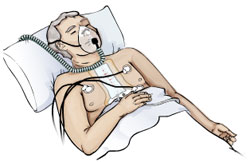Perioperative Patient Simulation (POPS)

Perioperative Patient Simulations are intended to provide online practice for health care professionals caring for surgical patients during and after surgery. These simulations are based on mathematical models of the circulation and gas exchange in the lung. The initial values for all the variables in the simulation model are created from random numbers, so each simulated patient is unique. In all of the simulations, you may choose to treat neonatal, pediatric or adult patients.
Under development
Postoperative intensive care
Click here to see samples of the application
Click here to read more about the POPS application
Click here to open the POPS application.
The challenge
This simulation covers post-operative care of a cardiac patient. Your patient has just been admitted to the Intensive Care Unit (ICU) following cardiac surgery. The surgical repair was successful, but the patient may have complications of depressed myocardial contractility, bleeding, hypo or hypertension, hypo or hypervolemia, hypo or hyperthermia, heart block, tamponade, and anemia.
Your task
Your task is to return the patient’s heart rate, arterial blood pressure, left atrial pressure, cardiac index and temperature to acceptable clinical levels and maintain patient stability within these levels for one hour of simulated patient time. In this simulation, time is speeded up by a factor of 60: one minute of real time is equivalent to an hour of time for the simulated patient. However, time stops while you are selecting your treatment options, so you have a chance to think about the intervention without further deterioration of the patient.
Respiratory management
The challenge
This simulation will cover the management of a patient requiring respiratory support with a ventilator. The challenges to achieving adequate gas exchange are varying degrees of increased airway resistance, decreased lung compliance and cardiac shunts.
Your task
Your patient has been paralyzed and intubated and is being hand ventilated on 100% O2. Your task is to adjust the ventilator settings to maintain PO2, CO2, oxygen saturation and pH within normal limits for an hour of simulated patient time. The ventilator settings are adjusted using the controls on the simulated front panel the ventilator. In this simulation, time is speeded up by a factor of 60: one minute of real time is equivalent to an hour of time for the simulated patient. However, time stops while you are selecting your treatment options, so you have a chance to think about the intervention without further deterioration of the patient.

